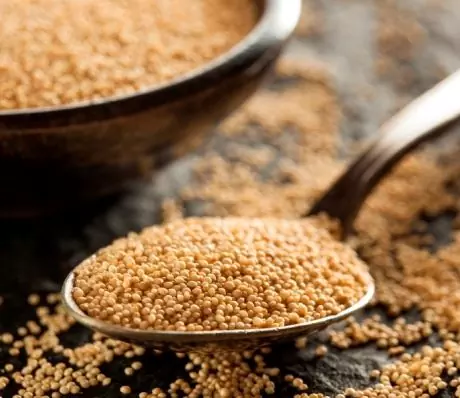- Author Rachel Wainwright [email protected].
- Public 2023-12-15 07:39.
- Last modified 2025-11-02 20:14.
Allspice
Allspice is an evergreen tree of the Myrtle family, reaching a height of 6-12 meters. Leaves are oblong-ovate, curled around the edges, with punctate glands. Inflorescences are small, white, collected in racemes. The fruit of the tree is green at first and turns red when ripe. Inside there are two or three chambers, each of which contains one black-brown seed.
The ratio of BJU in the product

Source: depositphotos.com How to burn 251 kcal?
| Walking | 63 minutes |
| Jogging | 28 minutes |
| Swimming | 21 minutes |
| A bike | 36 minutes |
| Aerobics | 50 minutes |
| Household chores | 84 minutes |
The tree loves lime-bauxite soil, which creates certain difficulties in its cultivation. The plant begins to bear fruit only in the seventh year of life. The fruits are harvested unripe, since when ripe they quickly lose their aroma and are of no value as a spice. They are dried in special ovens or in the sun, as a result of which they acquire a grainy surface and a rounded shape. From one tree, you can harvest up to 75 kg of fruits. The fruit diameter is approximately 5 mm.
History
In Europe, allspice is called the plant of Columbus, since it was he who discovered it. Nowadays, the plant is also called "Jamaican pepper".
The plant began to be used as a seasoning in Europe at the end of the 17th century. It quickly gained popularity and was in demand due to its specific scent. Compared to the exotic spices already known at that time, allspice was something special and unusual. In the Czech Republic, for example, he was nicknamed “new seasoning”. And in England, dried peppers were called "English".
The aroma of pepper is associated with mustard, cloves, cinnamon, nutmeg, black pepper, therefore it is called "all spice", that is, "universal seasoning."
The homeland of the plant is India, as well as Central and South America. Francisco Fernandez, French scholar, 1571-1577 traveled to Mexico on behalf of King Philip II and encountered this plant in the Mexican state of Tabasco. Therefore, he nicknamed the plant "Piper tabasci". There he learned that the Aztecs used this seasoning together with vanilla to add flavor to the chocolate drink.
The plant grows wild in southern Mexico, the islands of the West Indies, Venezuela, Costa Rica. It is cultivated in Indonesia, Mexico, Vietnam, Sri Lanka, Haiti and Cuba. The main producer of allspice today is Jamaica.
In 1925, the largest harvest of allspice was harvested - 6 thousand tons (usually no more than 4.5 thousand tons are harvested per year).
Allspice composition
100 g of pepper contains 8.46 g of water, 21.6 g of fiber, 4.65 g of ash; vitamins: A, B1, B2, B6, C; minerals: selenium, copper, zinc, manganese, iron, sodium, phosphorus, calcium, magnesium, potassium.
The composition of allspice contains essential oils 3-5%, tannins, spicy fatty oil, resins.
Eugenol, caryophyllene, cineole and fellandron were found in the essential oil.
The use of allspice in cooking
In cooking, allspice is often used as a substitute for black. Actually, this is a hot seasoning, which is undesirable to abuse. This spice is one of the constituent components of "curry". They add it to cakes, liqueurs, cookies. If you season a fat sauce with allspice, it will turn out not only very tasty, but will also have an exquisite aroma. This spice is added to a wide variety of dishes: spinach, fried fish, jellies, soups, fish salads, pudding, sauerkraut, marinade.
Everyone will love the game if served with a sauce prepared according to this recipe: add black pepper, salt, flour, onion, lemon zest to the broth and cook over low heat, stirring occasionally. Then add a few peas of allspice and red wine - the sauce is ready.
No housewife can do without allspice in home canning, adding it to pickles and marinades intended for pickling and pickling vegetables, especially cucumbers, tomatoes, squash and zucchini.
Pepper found application in the alcoholic beverage industry. They are flavored with canned fish, salted herring, hard cheeses. In ground form, it is added to various sauces and mustard. Allspice goes well with various desserts, such as plum pudding or fruit compote. In powder form, it is added to sausages and confectionery products.
And tea with allspice is very useful for diarrhea. It should also be emphasized that pepper berries and essences are used in the perfumery, pharmaceutical and cosmetic industries.

Useful properties of allspice
In addition to its excellent taste, allspice also benefits the entire body. It contains a large amount of useful substances, so it is widely used in traditional medicine. For example, it has become widespread in the treatment of pinching of the spine and nerves. In this case, the pepper grains are first boiled, and then ground into powder. Also, boiled peppercorns are used for rheumatic diseases.
The essential oils that make up the pepper give a person additional energy, a charge of strength and vivacity. Also, essential oil is a natural antiseptic.
Contraindications
With excessive use of allspice, allergic reactions may occur.
YouTube video related to the article:
Found a mistake in the text? Select it and press Ctrl + Enter.






